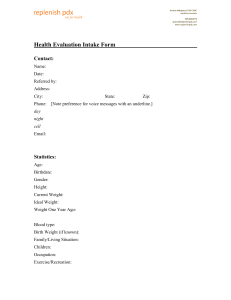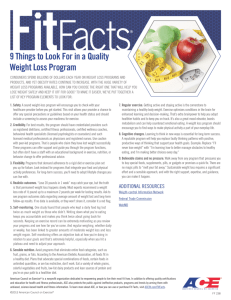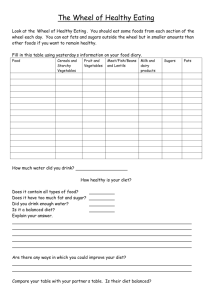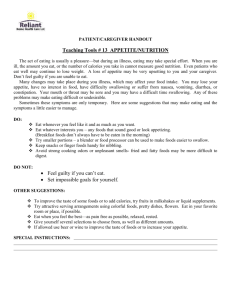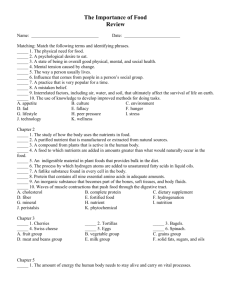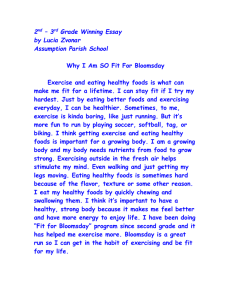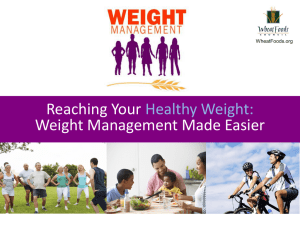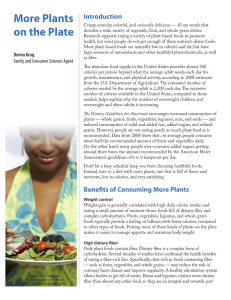9_12FE7045-TEST1 - Print Test
advertisement
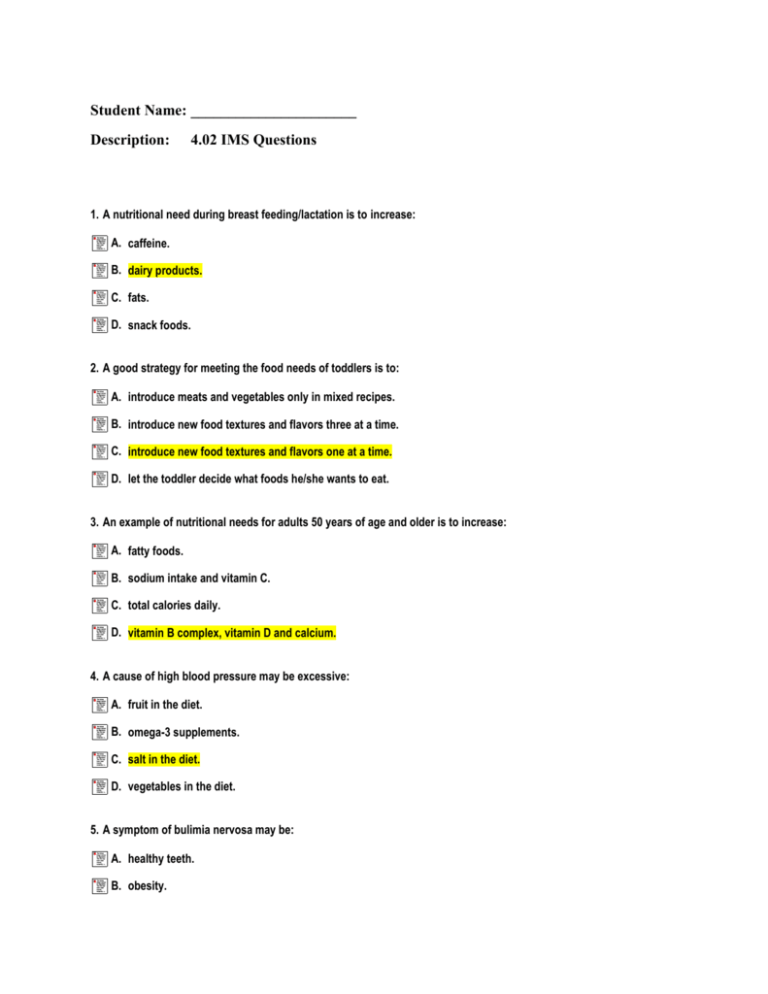
Student Name: ______________________ Description: 4.02 IMS Questions 1. A nutritional need during breast feeding/lactation is to increase: A. caffeine. B. dairy products. C. fats. D. snack foods. 2. A good strategy for meeting the food needs of toddlers is to: A. introduce meats and vegetables only in mixed recipes. B. introduce new food textures and flavors three at a time. C. introduce new food textures and flavors one at a time. D. let the toddler decide what foods he/she wants to eat. 3. An example of nutritional needs for adults 50 years of age and older is to increase: A. fatty foods. B. sodium intake and vitamin C. C. total calories daily. D. vitamin B complex, vitamin D and calcium. 4. A cause of high blood pressure may be excessive: A. fruit in the diet. B. omega-3 supplements. C. salt in the diet. D. vegetables in the diet. 5. A symptom of bulimia nervosa may be: A. healthy teeth. B. obesity. C. stained teeth. D. starvation. 6. An example of a healthy food choice for a toddler is eating: A. brightly colored fruits and vegetables. B. cookies. C. high-fat cheese. D. processed meat every day. 7. How do healthy snacks compare to junk foods? Healthy snacks are: A. higher in carbohydrates B. higher in fiber C. lower in fiber D. more expensive. 8. A common food allergen is: A. apples. B. bread. C. oranges. D. tangerines. 9. A common food allergen is: A. chicken. B. flounder. C. shrimp. D. turkey. 10. A common food allergen is: A. carrots. B. kidney beans. C. lettuce. D. tofu. 11. What is a primary benefit of a Hispanic eating plan? A. Ingredients are healthy, full of fiber, and fresh. B. Ingredients are pre-cooked. C. Ingredients are pre-packaged. D. Ingredients found at convenient store. 12. The primary concern and health risk related to an Asian eating plan is: A. heart disease. B. high blood pressure. C. obesity. D. stomach cancer. 13. How does a breast-feeding woman's diet need to be modified? A. Extra carbohydrates and water B. Extra protein and milk C. Fewer calories D. More salt 14. What foods have a positive impact on reducing high cholesterol? A. Corn flakes B. Crispy rice cereal C. Oatmeal D. Sugared corn flakes 15. What can be done to prevent osteoporosis? A. Drink plenty of water B. Eat high-calorie foods C. Get 8-10 hours sleep D. Walk and climb stairs 16. A major factor contributing to infertility among women of child-bearing age is: A. dieting. B. growth spurts. C. obesity. D. vegetarianism. 17. An example of a healthy food choice for a teenager is: A. eating fresh fruits and vegetables regularly. B. eating snack foods with natural sweeteners. C. reducing consumption of water and substituting soft drinks. D. skipping breakfast to avoid extra calories. 18. To cut calories, a person should select for dessert: A. apple pie and ice cream. B. chocolate pudding. C. fresh fruit cup. D. oatmeal raisin cookies. 19. An example of a healthy food choice for an adult is: A. eating dinner after nine p.m. B. picking up fast food on the way home from work. C. serving baked potato chips with sour cream dip. D. snacking on multi-grain crackers, fresh carrots, and celery. 20. A primary concern and health risk related to Caribbean eating plans is insufficient: A. fat. B. protein. C. starch. D. vitamins. 21. A major factor contributing to obesity among teenagers is that teens: A. are at a stage of life when it is normal to gain weight. B. are experiencing growth spurts. C. are more active than adults and children, therefore, more likely to gain weight. D. tend to choose many foods that are high in sugars, starches, and fats. 22. A cause of obesity may be: A. drinking diet sodas while continuing to eat high-calorie foods. B. exercising without getting adequate rest. C. having growth spurts. D. teaching certain ages and stages of development. 23. A person on a low-calorie diet should select: A. canned peaches in heavy syrup. B. coffee with sugar substitute. C. low-fiber cereal. D. small size of milkshake. 24. Which foods should be AVOIDED for toddlers and infants? A. Cereal for infants of 12-18 months of age B. Cow's milk for infants 0-6 months of age C. Juice for infants 6-12 months of age D. Solid foods for toddlers 2 years of age
